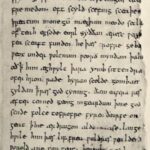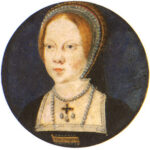In “Clay,” James Joyce illustrates through Maria’s contradictory characteristics the evolution of Christian celebrations from pagan roots. Joyce’s main character, Maria, is connected both to the Virgin Mary and the witch archetype. Maria’s relation to the Virgin Mary connects her to the Catholic Church of modern Dublin. In contrast, her association with the witch archetype connects her to the ancient Celtic religions of Ireland. Because the story takes place on Hallow Eve and Maria embodies both Christian and pagan characteristics, she represents the dual influences of Christianity and paganism on religious celebration in modern Ireland.
Several of Maria’s characteristics connect her to the Virgin Mary. First, Maria’s name is an alternate form of Mary. Second, Maria originally distrusted Protestants: “She used to have such a bad opinion of Protestants but now she thought they were very nice people, a little quiet and serious, but still very nice people to live with” (144). In Ireland, the battle between Protestants and Catholics is a crucial part of the history of the country. Since Maria attends mass and used to be distrustful of Protestants, one can assume she is Catholic.
Third, Maria’s unmarried and assumedly virgin status connects her to Mary. It quickly becomes apparent the Maria has had little experience with men. In fact, when the elderly gentleman on the tram is kind to her, she becomes so flustered that she forgets the cake she bought to take with her for Joe and his wife as she visits them on Hallow Eve. She is ashamed when she realizes her mistake: “Maria, remembering how confused the gentleman with the grayish moustache had made her, colored with shame and vexation and disappointment” (146). Her virginal status is suggested through her nervous reaction to the man’s attention. Similarly, her status as a virginal mother to Joe illustrates her connection to the Mary. That Maria was responsible for raising Joe and his brother Alphy becomes clear when Joe says, “Mamma is mamma but Maria is my proper mother” (144).
Finally, Maria’s talent as a peacekeeper connects her to Mary and Catholicism. Consider this: in Catholicism, Mary is seen as an intermediary between humankind and God. Catholics pray to Mary to intercede to God on their behalf because of her importance as the mother of Christ. In other words, they believe that a request by Mary will have more clout with God. Furthermore, Christ is called the Prince of Peace because through him peace is reestablished between God and humankind. Similarly, Maria acts as a peace mediator among the women she serves: “She was always sent for when the women quarreled over their tubs and always succeeded in making peace” (143). Maria is apparently liked by all of the women. The narrator tells us, “Everyone was so fond of Maria” (143). Therefore, her opinion is valued by them all. As a result, she is able to intercede and act as a peace mediator, or intercessor, like Mary.
Although Maria is connected to Mary and Catholicism, she has contradictory characteristics that connect her to the witch archetype and paganism. For example, Maria’s physical characteristics are witch-like. As Joyce’s narrator says, “Maria was a very, very small person indeed but she had a very long nose and a very long chin” (143). Her smallness of stature and exaggerated features connect her clearly to the witch archetype. In addition, her full-bodied laughter brings to mind the cackling of a stereotypical Halloween witch: “And Maria laughed again till the tip of her nose nearly met the tip of her chin and till her minute body nearly shook itself asunder […]” (144). The strange imagery associated with her physical features and laughter reveals her relation to the witch archetype.
Furthermore, Maria is associated with witchcraft through her hobby, growing plants. Maria grows plants and gives them to her visitors: “She had lovely ferns and wax-plants and, whenever anyone came to visit her, she always gave the visitor one or two slips from her conservatory” (144). Plants and herbs are important substances used in spells and potions; thus, her conservatory connects her to pagan herbalists or witches. The fact that Maria embodies characteristics of both Mary and the witch archetype reveals her connection to the changing face of religious celebration in Ireland. Furthermore, the fact that Maria herself is moldable (for example, she changes her opinion about protestants) reinforces this interpretation.
The title of the story, “clay,” reinforces Maria’s connection to change. Like Maria and religious celebration, clay is changeable and moldable. For example, one may sculpt and mold a piece of clay into a particular form; however, after finishing the piece, one may decide that the finished work is unsatisfactory and reshape the clay into something different. In considering the nature of clay, one can see how Joyce’s title connects to the history of religious celebration in Ireland, specifically, how Christian celebrations evolved or were molded from pagan roots. As Christianity spread throughout the Celtic world, the church revamped pagan rituals, celebrations, and doctrines to draw pagans into the church. For example, Samhain (the ancient Celtic festival of the dead) evolved into a church sanctioned Hallow Eve (the eve of all Saint’s Day) or Halloween. In addition, the importance of the Virgin Mary in the Catholic Church illustrates another way in which pagan roots evolved into Christian doctrines. Consider that most pagan religions place importance on duality (the worship of both the God and Goddess); consequently, the duality between the feminine and masculine aspects are recreated in the Catholic Church through the importance placed on Christ (masculine) and Mary (feminine) elements of the Church doctrine. In “Clay,” James Joyce uses the setting and the contrast between Maria’s Christian and pagan traits to illustrate how the celebrations of Ireland’s pagan past were molded by the Catholic Church to conform to the views of the present.






